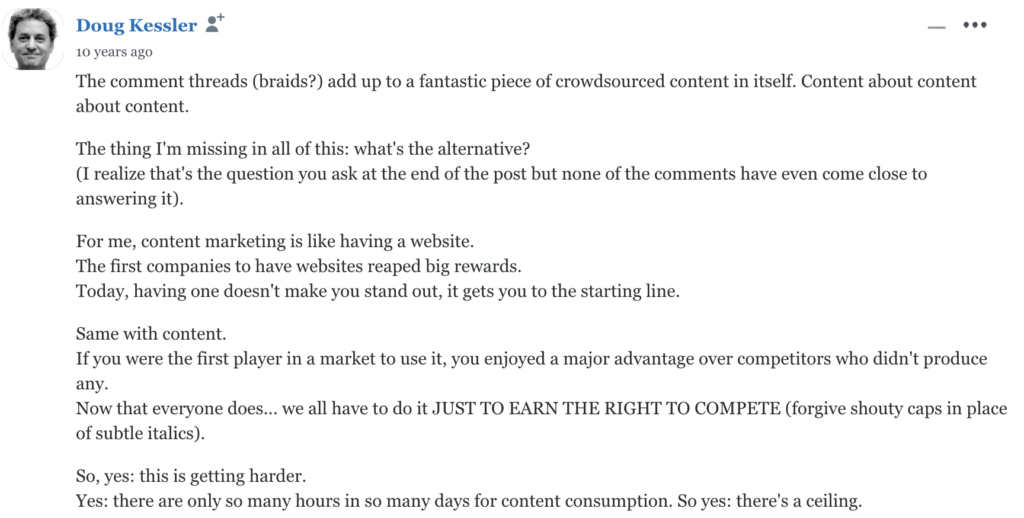
This week marks the tenth anniversary of the most famous blog post I’ve written, and arguably one of the most well-known blog posts in marketing history. I am not one to reminisce or grow crazy over anniversaries, but publishing this post ten years ago was a unique, unexpected life experience and cultural moment worthy of explanation.
Today, we’ll look at the impact of Content Shock and lessons from one of the most widely shared business blog posts in history.
The idea behind the blog post
It was the summer of 2013. I was on a plane to give a speech in Montreal, but I couldn’t relax because I was uneasy about my talk. The topic was familiar enough — social media and content marketing. But something was wrong.
Back then, producing corporate content was still a novel idea. Content fueled this concept of inbound marketing. Instead of cold-calling customers (outbound marketing) we could produce relevant content that would auto-magically bring leads to our website.
But it wasn’t working, at least not as easily as it had in the early days. The leading purveyor behind the idea, Hubspot, had never turned a profit (ironically its OUTBOUND sales costs were too high!). Niches were filling up with blog posts and podcasts and infographics competing for attention. We had to spend more of our budget on quality and promotion just to get a few views. And it was just getting worse.
The world was flooded with content, and the easy days of content marketing were coming to an end. On the plane to Montreal, I scribbled a note — “The world is in content shock.”
The premise
When I have a new idea for a book or blog post, I never go with it right away. I let it sit for months to make sure I’m right.
 I didn’t publish the Content Shock post until January 06, 2014. I had seen enough by then to know I was right. It was simple economics: Any time there’s a huge surplus of a good, or a scarcity of a good, there has to be a response in the economic system. And we had a surplus of content!
I didn’t publish the Content Shock post until January 06, 2014. I had seen enough by then to know I was right. It was simple economics: Any time there’s a huge surplus of a good, or a scarcity of a good, there has to be a response in the economic system. And we had a surplus of content!
Here’s a simple example. In the earliest days of TV, anybody could walk down to a studio and create a cooking show or a craft show. The entry barriers for success were low because the channel was so hungry for content. Similarly, in those early days, it was easy to advertise and support a show.
As television became more popular, the channels filled with content. Competitors appeared, not just on the local level, but nationally. Networks were created that attracted the best writers and the biggest stars. Content became more expensive to produce and sponsor.
Television entered a never-ending content arms race. You can still see it happening today. An episode of The Mandalorian cost a staggering $15 million to produce. A few years later, Wanda Vision cost $28 million per episode. The Lord of the Rings TV series cost $60 million per episode.
And so it goes.
This is exactly what is happening on Facebook. On Instagram. On Tik Tok. On every place we publish, whether it is B2B or B2C.
And so, I decided to write about this pattern. Content marketing was moving into a new phase, and it wasn’t going to be easy.
The outfall
Today, this idea of Content Shock is taken for granted. Of course if there is more competition, it becomes more difficult and expensive to compete. In fact, it becomes impossible for some.
While I knew this idea was true, I nonetheless sensed it would not go over well with the people in the industry actually selling content marketing as a red-hot, can’t-fail idea.
The post attracted thousands of comments — more like long conversations! To my surprise, about 95% of the comments were positive and suggested that I had tapped into a market reality, like this one from marketing expert Doug Kessler:

And yet, my blog post was characterized as “controversial.” If 95% of the people agreed with me, why would it be controversial? As I explained to my wife, if 95% of the people in our country agreed with something but the president disagreed, it would be controversial.
In this case, almost every content marketing thought leader took aim at me. I was fine with it. I have a thick skin and enjoyed the great debate. That’s how we grow. But there was one comment I’ll never forget …
The laugh
The commentary didn’t end at my blog. My post sent a ripple of conversation into seemingly every blog, podcast, and video in the marketing industry. It was great that a professional debate was happening … with one exception.
On a well-known podcast, one of the hosts was asked whether my article had any legitimacy. He paused … and then laughed. “NO!” he said emphatically. He went on to describe the practice of content marketing as having unlimited potential. There was no concern about content saturation or the economic viability of content marekting, he claimed.
In my 15 years of blogging, this is the only comment that ever truly, deeply pissed me off. It wasn’t because he disagreed with me. It was because this was a respected voice acting as a charlatan to protect his own business interests. He was lying to an audience I cared about.
This comment was the primary reason I wrote The Content Code book. I needed to insert some rational truth into the content marketing madness. The premise of the book: “The economic value of content that is not seen and shared is zero. Here is a plan to ignite your content in an era of Content Shock.”
The laugh launched a book. And I’m still a little pissed : )
The legacy of a blog post
The Content Shock post generated tens of thousands of comments all over the web. For three solid weeks, I spent almost every hour of the day responding to comments. An important point — this most viral of posts had no measurable impact on my business. It did not even result in a meaningful boost in new subscribers. Goes to show that “Viral” is an overrated goal.
Hundreds of blog posts have been written about the original post. Thousands more linked to the article. I continue to get links to that post every week. “Content Shock” is still among the top 10 posts on my site every week, 10 years later!
Over time, the industry adopted the term as a way to describe the overwhelming competition in a world saturated with content. It has been featured in books, conferences, and speeches around the world. I’ve had people describe Content Shock to me, not realizing I was the one who came up with the term.
Two years after I wrote the post, Buzz Sumo did an analysis of marketing content trends, showing that content saturation was eating into the success of some of the biggest sites in the industry like Copyblogger and Moz. Founder Steve Rayson stated that “content shock is here.”
Battling the difficult economics of content saturation is a fact of life today in the marketing world!
Spiky content
Why did this post go viral? It was timely, it was relevant. But it was also spiky.
In my Personal Branding Master Class, I teach about the importance of “spiky content,” a phrase coined by Wes Kao. Spiky content provides a bold point of view that cuts through the clutter. It goes like this:
1. A spiky point of view can be debated.
2. A spiky point of view isn’t controversial for the sake of it.
3. A spiky point of view teaches your audience something relevant they don’t already know.
4. A spiky point of view is rooted in evidence, but it doesn’t have to be a proven fact or universal truth.
5. A spiky point of view requires conviction.
“Content Shock” is a great spiky case study!
When I wrote this post, did I know I was absolutely right? I thought so, but there was no way to know for sure. The argument was built on evidence, but of course, it could be debated. And I wasn’t taking a stand to start a fight. I thought about this idea for six months before publishing. I wrote this post because I’m passionate about marketing, and I care about its future.
If you care about something, try creating some spiky content of your own. It’s really the only way to stand out today.
The future, the solution
After the initial post, I had another insight about Content Shock. It’s not just a trend. It’s a pattern (I explained this here). Every channel eventually fills with content, driving up the cost to compete. It’s a repeating pattern.
I wrote several follow-up posts, including one framing Content Shock as the most important content marketing strategy, instead of being a problem.
If Content Shock was becoming an issue in 2014, you can only imagine what is happening today in a world overtaken by AI. Some project that in a year or two, 95% of the content on the web will be created by bots. Bots don’t sleep, they don’t get writer’s block. Their ability to churn out content is infinite.
One of the counterarguments to Content Shock was that the world wasn’t being saturated with content; it was being saturated with bad content, so true artists still had a chance. Perhaps that was valid for a time, but most niches are filled with great people doing great work, or AI bots that are not far behind. The world is filled with so much great content, all of it vying for our attention.
Content Shock is here to stay.
I think there are two solutions to Content Shock.
The most common path is the inevitable arms race. Just look at what is happening in the battle between Netflix, Apple, and other streaming services. The demand for quality content, and the cost to produce that content, goes up, up, up. That is the inevitable pattern in every content niche.
There is another solution. What if you cared for the content and even more for the person or brand producing it?
Why are you reading this today? If you’ve made it this far, it’s because you’re interested in the topic. But maybe you subscribed to this blog in the first place because you believe in me. Maybe you will share this post on LinkedIn because you consider me a thought leader, or even a friend. The content matters and cuts through because I matter to you as a person.
This is a solution available to any business of any size, and it’s why I shout from the rooftops every day that you MUST be working on your personal brand.
I don’t have the resources to compete with the biggest media sites and cut through the Content Shock. You probably don’t either. But you can be the most human company in your niche and nurture an audience who loves you as a person.
![]()
Thanks for obliging me this Content Shock retrospective. It was a weird time in my life, but overall, it produced positive results and I’m proud of the blog post.
Go forth and publish some spiky content! Thanks for being here and supporting me through these many years.
 Need a keynote speaker? Mark Schaefer is the most trusted voice in marketing. Your conference guests will buzz about his insights long after your event! Mark is the author of some of the world’s bestselling marketing books, a college educator, and an advisor to many of the world’s largest brands. Contact Mark to have him bring a fun, meaningful, and memorable presentation to your company event or conference.
Need a keynote speaker? Mark Schaefer is the most trusted voice in marketing. Your conference guests will buzz about his insights long after your event! Mark is the author of some of the world’s bestselling marketing books, a college educator, and an advisor to many of the world’s largest brands. Contact Mark to have him bring a fun, meaningful, and memorable presentation to your company event or conference.
Follow Mark on Twitter, LinkedIn, YouTube, and Instagram
Image courtesy Midjourney


